Starting a blog has many benefits for your professional life. For one, it positions you as an expert on that given topic. It can also help you gain exposure in your field, and perhaps even land a new job.
But one thing many people struggle with when first starting out, or even a few years in, is getting readers to come to their blog.
After finally getting it right with learntocodewith.me, I decided to create a four-part guide showing how to attract first-time visitors to your site when starting out. And more than that, how to get visitors to come back again and again.
If you’re interested in learning even more about blogging, make sure to download my free blogging guide below.
Blogging 101
Want to start blogging? Then you MUST download my ultimate guide!
Table of contents
- Part 1: Build a strong foundation
- Part 2: Content strategies to increase traffic
- Part 3: Tactical strategies for building blog traffic
- Part 4: Nurture existing readers so they come back for more
Part 1: Build a strong foundation
Establish a clear blog topic
Many people want to start a blog that covers everything and the kitchen sink. You know: “It’s a lifestyle blog where I’ll write about cooking, fashion, home organization, and travel tips.”
While it may seem like a good idea, this is the opposite of what you should do. Instead, it is best to start small and expand over time. If the above sentence resonates with you—choose just one of those topics. So just cooking. (In fact, I’d suggest narrowing in even more than that—e.g. gluten-free cooking.)
When you start a blog that is too broad, you will never attract the right people. And it’ll be hard to gain recurring visitors when one day you talk about your trip to NYC, the next a recipe for gluten-free brownies, and then fashion trends for the spring. (Most people won’t care about all three.)
As Pat Flynn says, “The riches are in the niches.”
Identify a target blog audience
Also known as an “avatar” or “buyer persona”.
Just as you don’t want your blog’s topic to be extremely broad, you don’t want your audience to be, either. Because if you try to appeal to everyone, you’ll appeal to no one.
Your avatar is like your perfect reader. Get specific about who that is. Their age, gender, interests, profession, goals, and fears. Having an avatar in mind will help you make decisions like what to write about.
Many fear that if they get too specific, they’ll leave people out. That’s not the case. You’ll still attract people who don’t perfectly fit your avatar.
For instance, my LTCWM avatar is a 28-year old woman who is college-educated, and looking for a new web development career outside of what she is already doing. She lives in California with her husband. She is learning to code because she wants better opportunities and increased flexibility in her day-to-day, because she’s thinking of having children soon.
Here’s the truth: most of the LTCWM readers do not fit this very precise description. (I mean, it’s really specific.) Still, there are pieces of this persona that many can relate to in some way. And when I’m creating content, it gives me a person to speak to directly, which in turn helps me write in a more compelling way.
For more about creating an avatar, turn to Kate Erickson from EOFire. Although this article pertains to a podcasting avatar, it is still relevant to blogging.
Create content people want to read (it’s not all about you!)
Providing value for your target audience is paramount. When I finally understood this in late August 2014, there was an enormous shift in my blog readership.

Here’s the reality:
People don’t care about you. What they do care about how much you can help them. Before worrying about anything else (like needing a Facebook page or Twitter account), make sure your blog’s niche, and each piece of site content, is valuable. Will it help people? Will people care about it? Is this information actionable?
Ask yourself questions like these before writing any blog post.
You can determine valuable topics/blog posts ideas by:
- Seeing what kind of questions are being asked on Quora, Reddit, and Stackoverflow (the latter only if starting a coding blog) that relate to your topic. Are there any points that keep reappearing?
- Stalking other relevant online communities (Facebook groups, LinkedIn groups, G+ communities). Are there any questions that keep being asked?
- Using Buzzsumo (more on this later) to identify popular blog posts on your topic based on social media share count. If it’s already popular, that’s a good sign, but try to avoid rehashing things that have been covered to death already (unless you have a new angle on it).
- Analyzing the comment section on these posts: is there anything people are still confused about? Any info they wish was covered in more depth?
- Looking at relevant Amazon ebook reviews, specifically the reviews that aren’t 5-star. What do they think the book lacked? How can you fill in the gap?
When it comes to pinpointing valuable blog topics, it comes down to observing the discussions and sentiments around you. As you begin to build a blog following, you can ask your audience what questions/struggles they have as a way to generate valuable ideas.
And remember, if you create valueless content, your blog will never take off. It’s just not possible.
Avoid the plague of perfectionism
When starting out, it’s easy to fall into the trap of waiting to launch your blog until everything is “perfect”. But guess what? IT NEVER WILL BE!!!
As Reid Hoffman said, “If you are not embarrassed by the first version of your product, you’ve launched too late.”
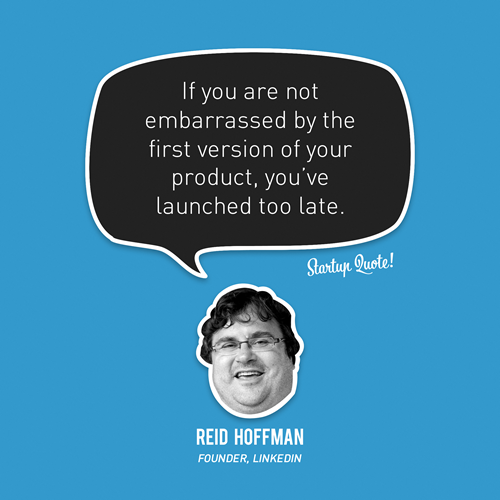
The same rule applies to blogging. Getting it done is better than getting it perfect. Don’t allow yourself to become caught up in the nitty-gritty details: remind yourself that you can always fix mistakes later if you need to.
Besides, no one will read your blog at first.
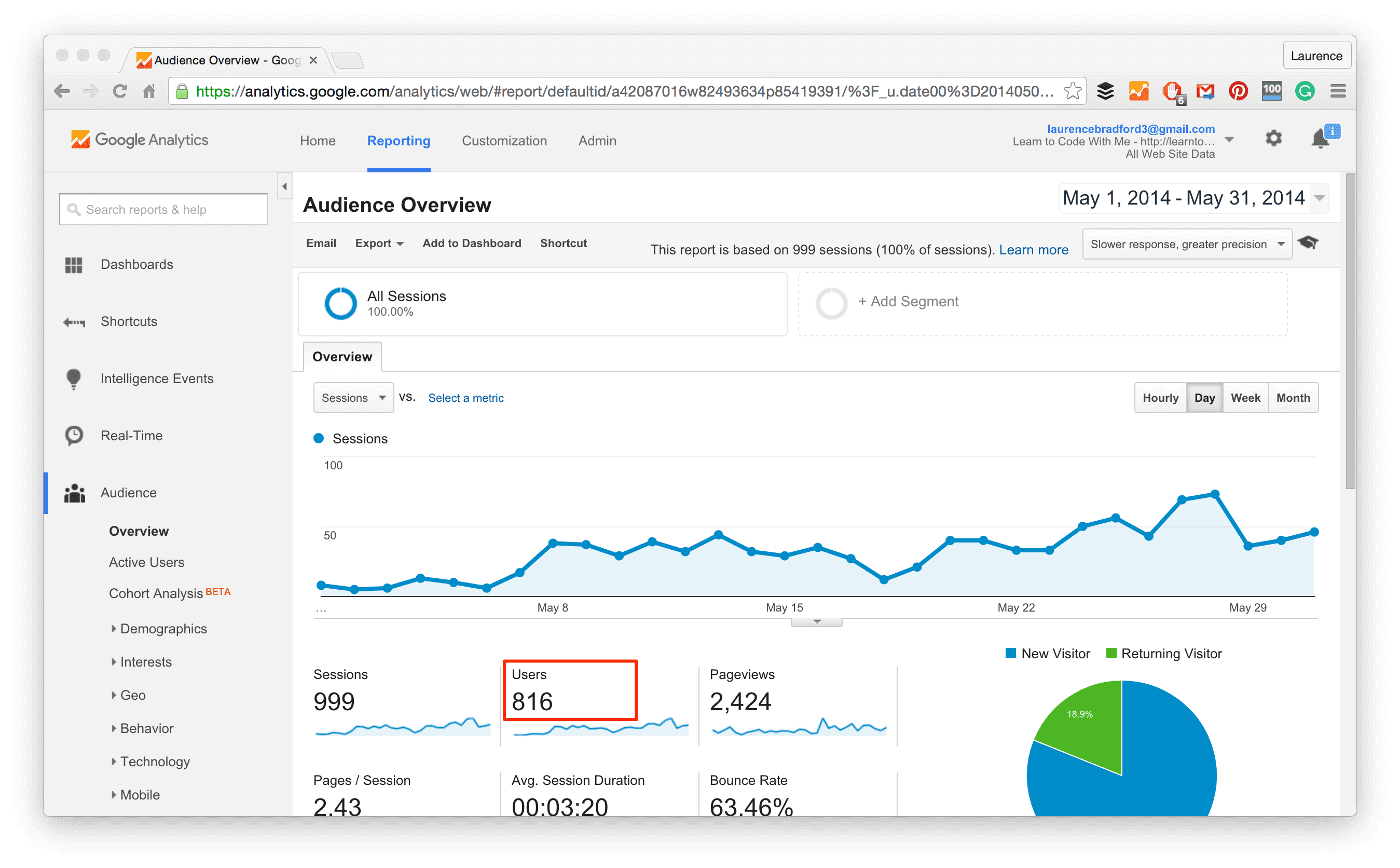
First full month on LTCWM, May 2014. In total, 816 people came in those 31 days. Today I get more than that in a single day.
This is because it takes time to build traction. (Patience is a key ingredient to any successful blogger.) Rather than becoming frustrated by this, use it to your advantage. Launch your blog as an ugly duckling, and turn it into a swan over time.
Here are a few things that people tend to get “caught up” in when starting their blog, but shouldn’t:
- A domain name (just use your name if you’re unsure, and know you can change it later by doing a redirect)
- Your site design/functionality (just use a WordPress theme for godsakes—you can improve it later!)
- A logo (again, you can get one later! I got a LTCWM logo a year after starting.)
- Your site’s color scheme (this will change over time regardless; I went through like three color schemes in one year on LTCWM.)
Trust me: NO ONE WILL NOTICE. And if they do, they won’t care. And if anyone does care, they need to get some hobbies. The truth is, most people are too busy to tell that you tweaked your logo, or changed your site’s color scheme ever so slightly.
Part 1 Takeaways:
- Narrow your focus into one clearly defined topic; remember you can always expand it later.
- Establish a clear blog audience, or avatar.
- Create helpful content that matters to your target audience.
- Don’t nitpick. Put your blog out there already! You can always modify the design, logo, etc. later.
Head back to the table of contents.
Part 2: Content strategies to increase traffic
Create intriguing headlines for your blog posts
Headlines matter so much that there are entire books dedicated to strategies for creating them. They determine whether a person will click to read your article. According to research by Copyblogger, “On average, 8 out of 10 people will read headline copy, but only 2 out of 10 will read the rest.”
When a person comes across your article on social media or a search engine, the headline is your one chance to pique their interest. (But don’t fall into the trap of being overly “clickbaity,” which just cheapens your brand.)
To help you take your headline to the next level, use the free CoSchedule Headline Analyzer:
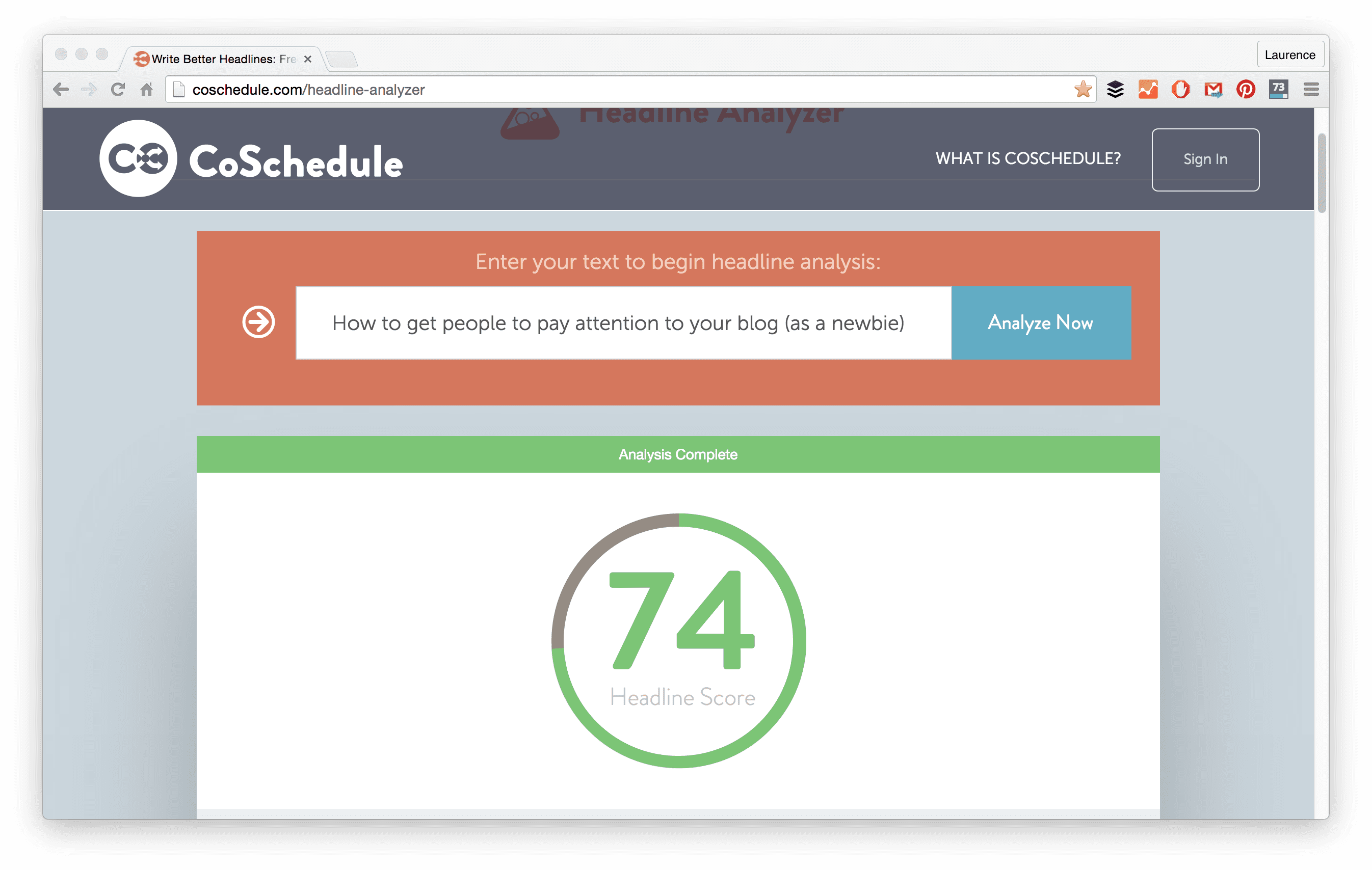
This analyzer gives your headline a score based on various metrics like character count, article type, and word usage. It also gives you suggestions on how to improve it.
For more on crafting headlines, check out Headline Writing 101: How to write attention grabbing headlines that convert by Neil Patel, and Statistics prove these content headlines get results by Mike Giannulis.
Make your meta description compelling
Your meta description is important because it appears in Google search results and as part of the preview when sharing on social media. (Like, the text that appears with updates on Facebook.)
If you’re a WordPress user, plugins like Yoast SEO allow you to customize your meta description for each new page and post.

Like your headline, this snippet is a first impression that determines the likelihood of a person clicking to read the rest of your article. So make it interesting! It should also reflect the contents of the article itself, acting as a preview of sorts.
If you can, try to incorporate some keywords that relate to what your blog post or page is about. As you can see in the image above, I used the words “blogging” and “blog.”
Use (shareable) imagery
Articles with (relevant) images amass 94% more total views than articles without images, according to Jeff Bullas. This is because we are naturally drawn to imagery. Plus, images act as a nice way to break up large blocks of text and illustrate concepts.
You can include free stock photos, screenshots, or images you make yourself.
Aside from images within your post, also use an appealing feature image. Featured images appear when you share a post on Facebook, Twitter, Google+, and even LinkedIn.
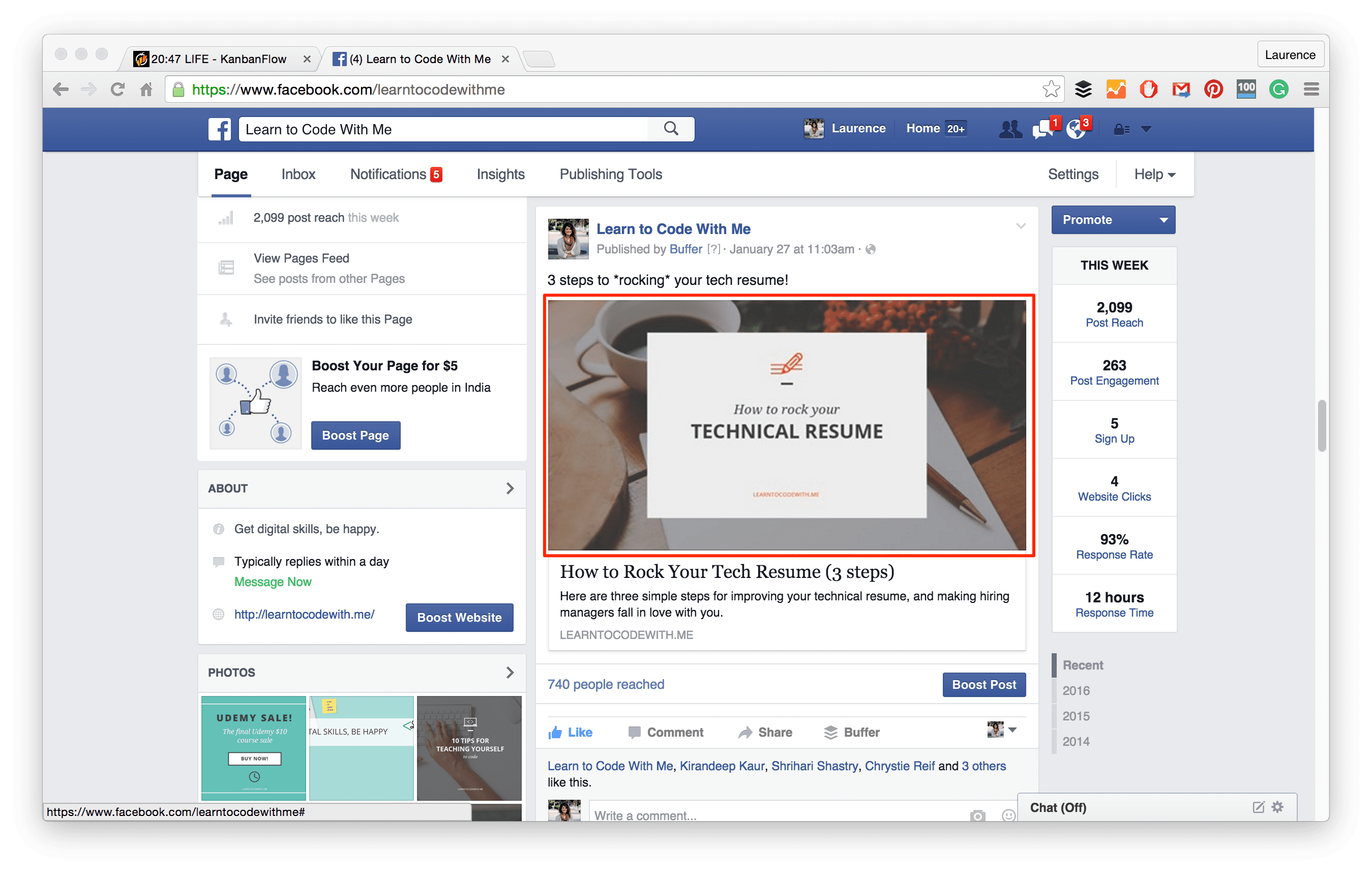
Not much of a designer? No problem. Use a free in-browser program like Canva or Snappa which offer ready-to-go blog post templates.
Improve as a writer over time
When I look back at my early LTCWM blog posts, I cringe in embarrassment. Any writer, designer, or web developer will share similar sentiments: “Ahhh! What was I thinking?! Look how far I’ve come!”
When first starting out, don’t expect to win a Pulitzer prize. Here are some general writing rules to follow when crafting blog posts:
- Be conversational: This isn’t academic writing! You want people to be able to relate to you.
- Keep your writing at a low reading level: As in, grades 6 through 8. Stay away from complex jargon, because you want everyone to be able to understand your writing (without feeling like they’re studying vocabulary words for the SAT). Also keep in mind that you may have readers from different countries who know English as a second language!
- Avoid fluff: Get to the point, and avoid cluttering your sentences with unnecessary words.
- Stay on topic: If your post is about CSS hacks for navigation bars, don’t get sidetracked into two paragraphs about your cat, Mittens. It’s easy, especially as a newbie, to veer off. But stay focused.
- Tell stories: When they’re relevant and relate to your topic, stories engage your audience and make you more relatable. (And as a result, make your blog more enjoyable to read!)
- Pay attention to formatting: This doesn’t relate to writing per se, but does relate to how people will consume your writing. Avoid large blocks of text. Use lists when appropriate. Break content into sections by using headings and subheadings. Use blockquotes, and bolded text, when relevant. While we don’t like to think about people skimming our content—they do. And you want to make sure your content is digestible for skimmers.
Fortunately, there are tools available to help you become a better writer. Here are two of my favorites:
- Hemingway app: a completely free in-browser tool (there is also a desktop application) that tells you if your sentences are difficult to read or not and gives you pointers on improving. It also gives your writing a reading level.
- Grammarly: a wonderful Chrome extension, in-browser tool, and desktop application. The tool actually helps you become a better writer by pointing out your mistakes and offering solutions, going beyond normal spell check to address things like comma placement and word usage. I use their premium plan, but they have a free option, too.

Mastering the art of writing takes time. The more you do it, the better you become. But it’s also important to become better over time by using tools (like the two mentioned above) or working with an editor who can give feedback on your work.
Part 2 Takeaways:
- Create an intriguing headline + meta description for all pages/posts.
- Incorporate imagery in your blog posts (and create a compelling feature image).
- Improve as a writer over time by getting feedback.
Head back to the table of contents.
Part 3: Tactical strategies for building blog traffic
Promote your blog posts like a madman (or madwoman)
Writing and publishing blog posts is just part of the equation. In order to get visitors to your site, you must also promote them.
In fact, some argue that blog post promotion is more important than creating the blog post itself…and that 80% of your time should be spent promoting, versus only 20% writing. (Personally, I think the percentage breakdown depends on your goals.)
But if you’re a blogging newbie, putting yourself (and new posts) out there is critical. This doesn’t mean you have a new post every day or even every week. Even every month. (I spent the last year writing for other sites more than my own, and publishing every 4-6 weeks. Only now am I started to write more regularly.)
If you don’t like the idea of “selling” yourself, think about it like building relationships and making connections. Whatever makes you feel most comfortable.
Here are some of my favorite ways to promote your blog/self:
- Guest post (write on other websites that relate to your blog’s topic. This is one of my favorite methods.)
- Get interviewed on podcasts (ideally, podcasts that relate to your blog)
- Speak at events (or simply attend events and make sure to rub elbows with attendees)
- Join online communities—Facebook, LinkedIn, and Google +—where your blog’s audience hangs out (you can share your blog posts when relevant)
- Share your blog posts on social media (more about this next)
- Answer questions on Quora, Reddit, and related forums (linking to a blog post you wrote when relevant)
- Connect with other bloggers in your field (link to them on your blog, share their stuff on social media, and they’ll usually return the favor to you)
- Ask your friends and colleagues to share your posts on social media
Get your butt on social media
Being on social media is important. It can create exposure, and thus traffic, to your site. But puhhhleasseee don’t go overboard by signing up for every social media network at once. Instead, focus on 1-3 platforms at first. Add more over time if you desire.
Here’s how you can determine which social media sites to be present on:
- Having a Facebook page and Twitter account are pretty much non-negotiable nowadays; in my opinion everyone should be on those two if they want to gain a blog following.
- Go where your audience already is. Example: if you’re starting a makeup/fashion/food/fitness blog, consider Pinterest since that kind of content is already a hallmark of that platform.
- Build a presence on platforms you enjoy using. For instance, if you love making videos, create a YouTube channel.
Social media has more value than just attracting new site visitors. These platforms allow you to connect with influencers in your space, build connections with other bloggers, and stay connected with your existing audience on a medium beyond your blog.
A quick word of warning: You always want to prioritize your blog (and email list) first. Since you don’t “own” your social media accounts, you shouldn’t spend too much time building them up.
You’re building these followings in somebody else’s “house”. And if the platform were to go under, all your efforts (and following) would be lost, too.
Blogging 101
Want to start blogging? Then you MUST download my ultimate guide!
Put smart SEO strategies into practice
SEO is critical. However, don’t obsess over it: as long as you master a couple basics, you’ll be fine. You can spend hours upon hours researching keywords, tweaking your site’s meta information and so on. But what matters more is creating awesome content for your audience.
Compared to others, I spend little time on SEO. Here’s what I do:
1. Before writing new posts, I take about 30 minutes to research key phrases and popular content on the topic.
First, I use Google to search key phrases people search that relate to my topic.
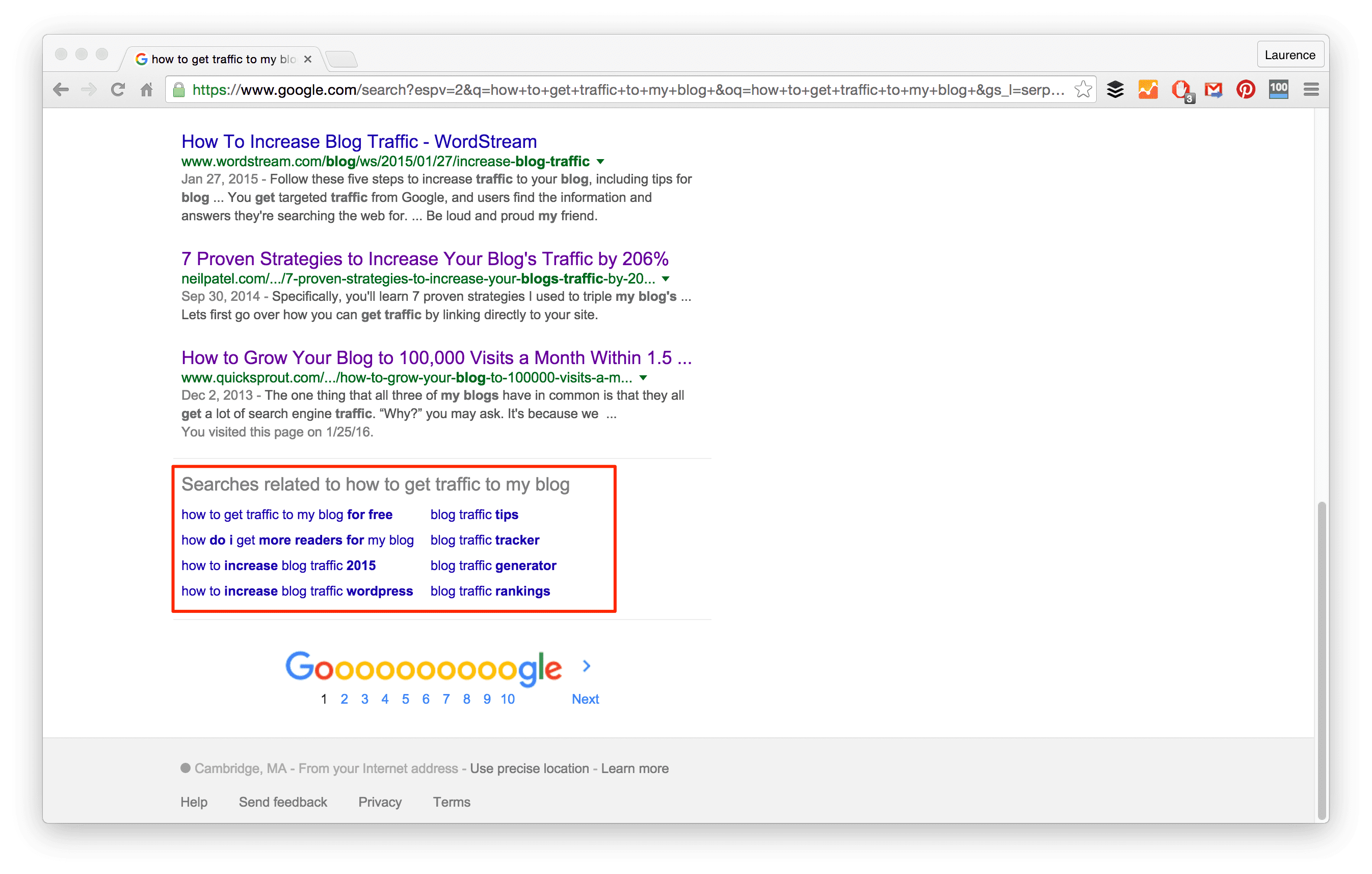
It’s super simple: I just type in some phrases around the topic into Google, and then scroll to the bottom of the first page. These related searches show common phrases people will type into Google. The goal of this is to see the language people are using when searching on the topic.
Then, I use Buzzsumo (I use their pro plan) to see what articles on that topic are already popular.
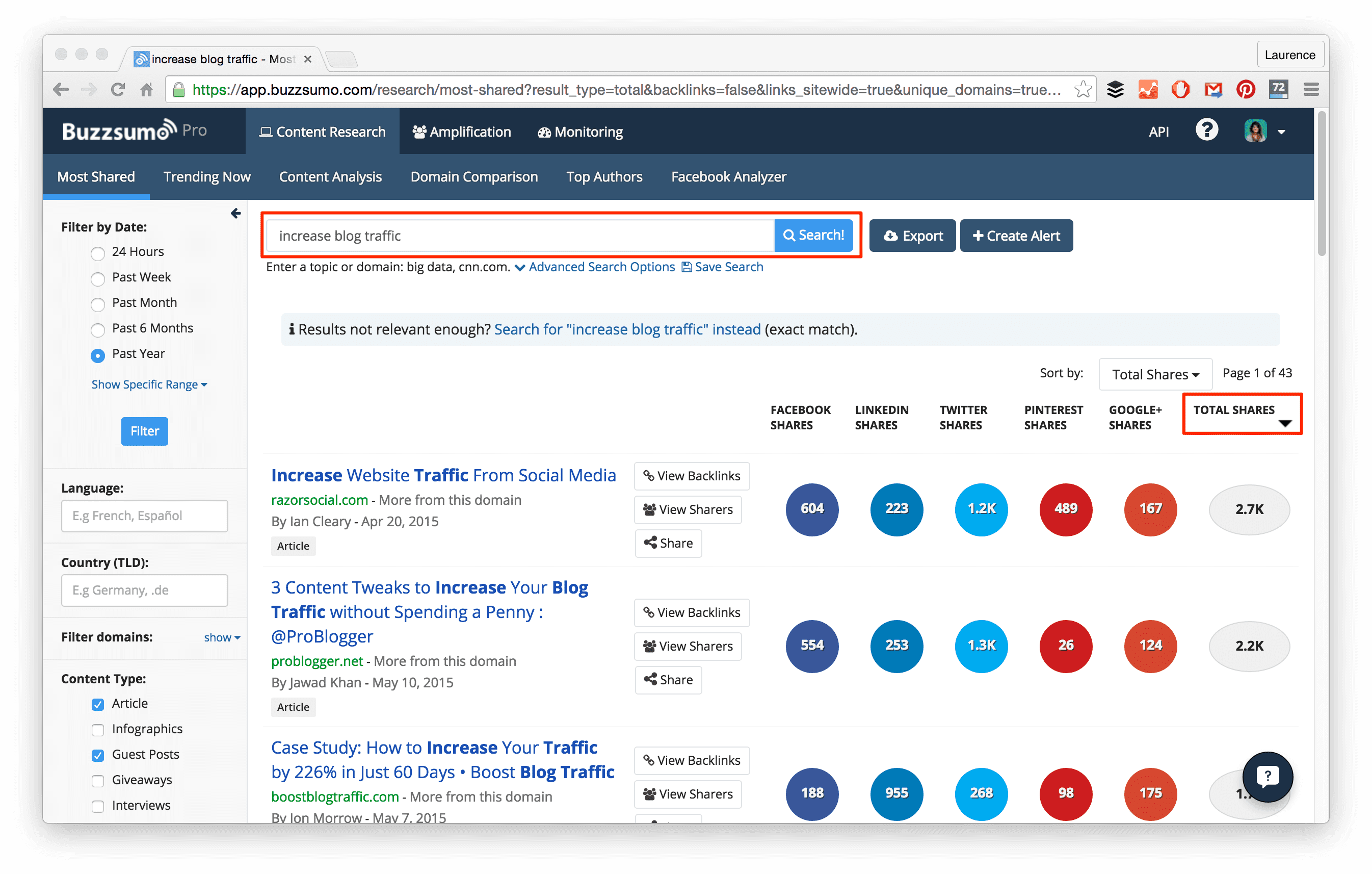
Buzzsumo allows you to see what content is most popular based on total social media shares. As you can see above, all I did was type in a phrase—like I did on Google. It’ll then generate a list of most-shared articles with those terms in the title.
Here’s what my research looks like before I begin writing a new blog post.
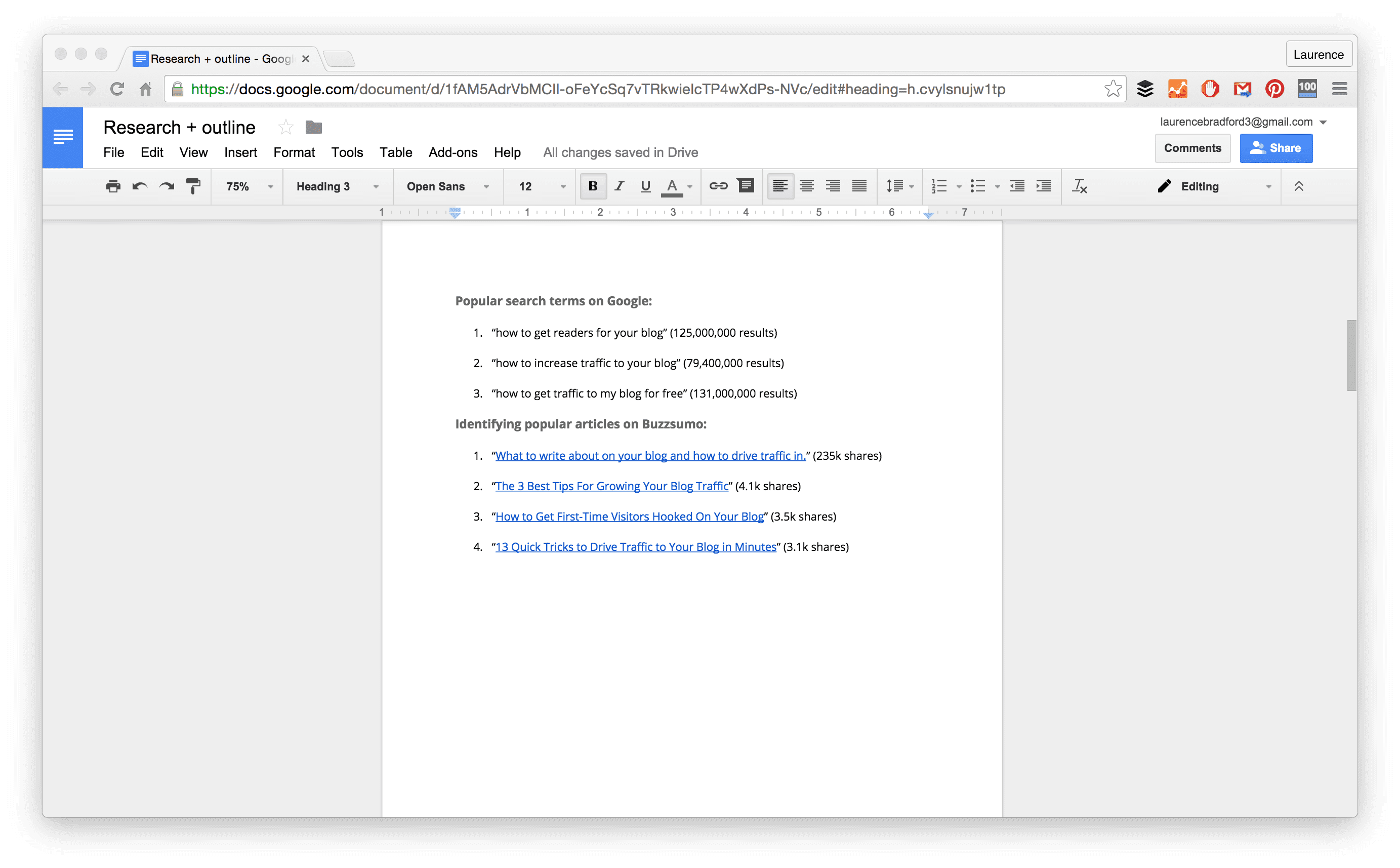
2. I use the Yoast SEO plugin for new pages and posts.
This plugin is the only SEO tool I use on the LTCWM site itself. Every time I write a new post, I fill it out completely.
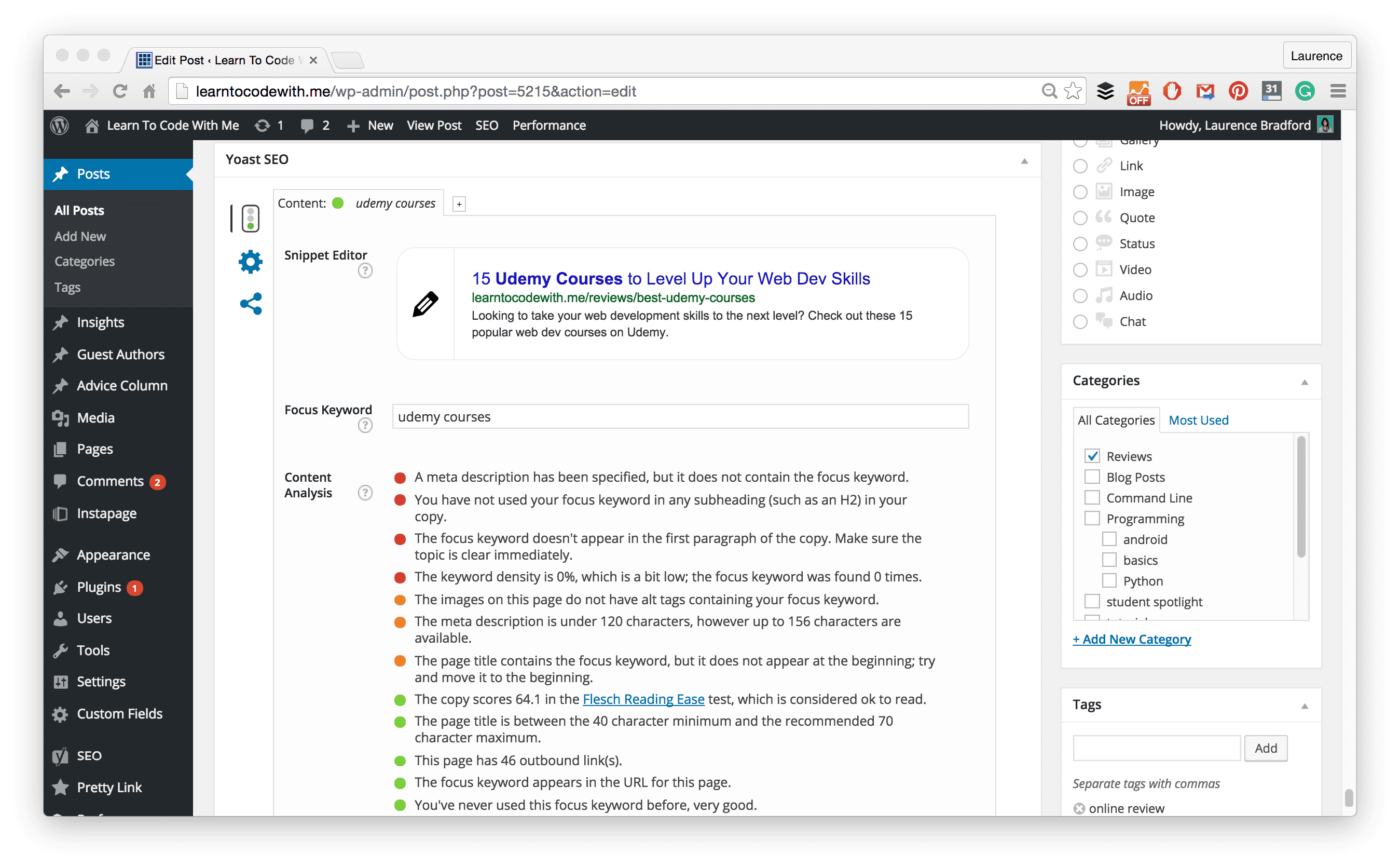
Above is the Yoast plugin filled out for this Udemy blog post.
SEO matters because, if you’re doing it right, organic search (traffic coming from a search engine) should be responsible for 50% or more of your blog’s traffic. As you can see, 73% of my traffic in a 30-day period comes from organic search. This figure is pretty standard.
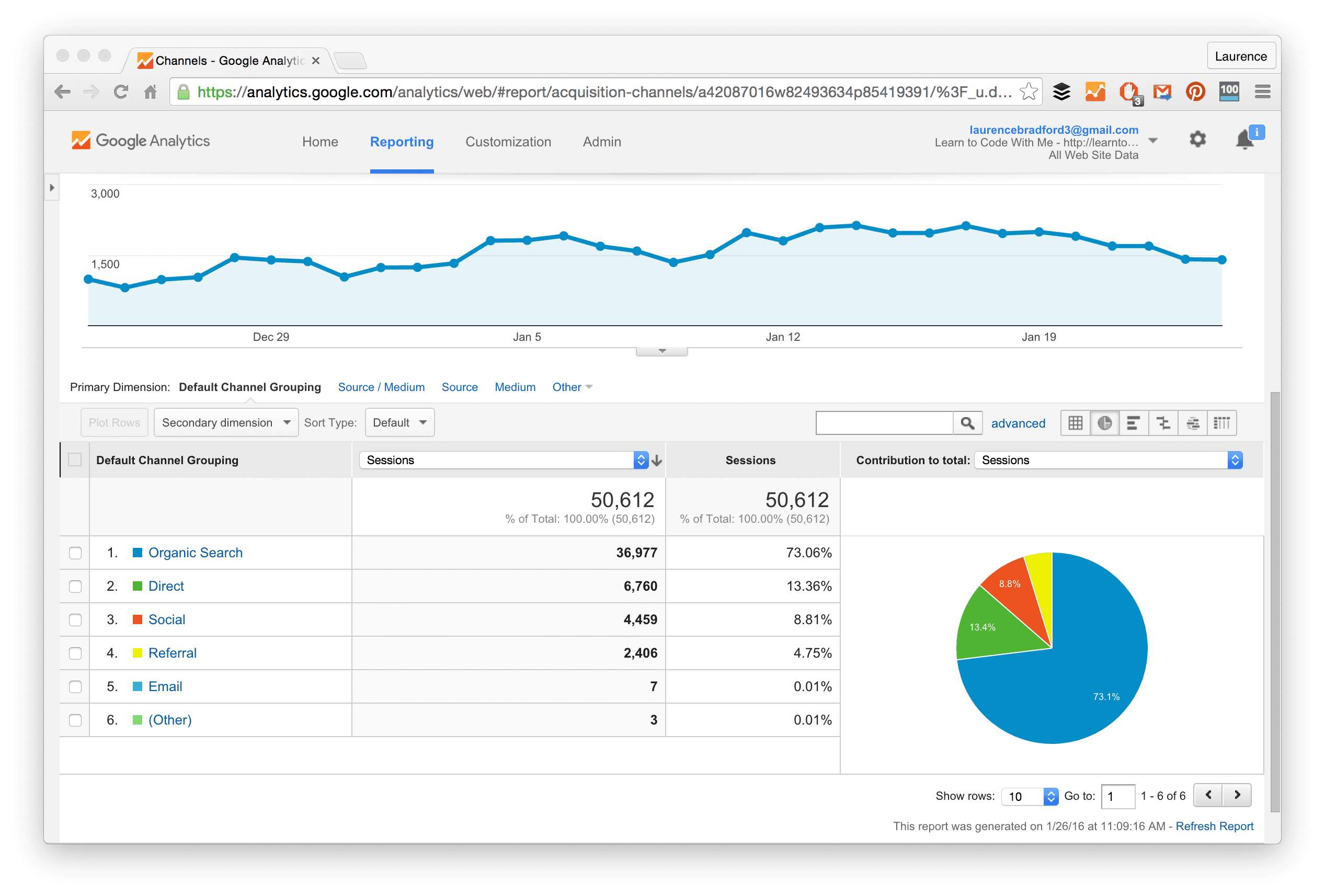
If you’ve been blogging on your site for six months or less and have little traffic from organic search (or none)—don’t panic. Realize that it can take a while for Google and other search engines to index your site so it will appear in the results. It took LTCWM a few months to really get noticed by Google.
However, if you’ve been writing for one or more years and your organic search traffic is still minimal, you may need to do some work on the content you’re creating and the current SEO practices you have in place.
At the end of the day, Google has tons of ranking factors. I take very few of them into consideration beyond the basics. But what I do consider greatly is creating stuff people will want to read. When you create awesome and helpful posts, Google (and other search engines) will show it to people. If your blog is boring and adding nothing new to the conversation, it won’t be shown to people.
Remember: Google’s goal is to show users the best and most relevant content based on their search query. They want the best articles on that topic to be at the top, easy for users to find. Trying to game the system is a waste of time.
Make it super easy to share your content
While a reader is on your blog, you want it to be incredibly simple for them to share the article that they’re reading.
Three words for you: social media buttons. There are lots of ways you can add them to your site.
- Custom-build them: This is what I have done on Learn to Code With Me, if you look to the left-side of this page (unless you’re on a mobile device). I used Sharrre to achieve this.
- Add them from the social site itself: e.g. Twitter “tweet” button and Facebook “share” button.
- Use a third-party plugin: e.g. the ShareThis WP plugin or related Share for SumoMe (which can be added to your site with a simple JavaScript snippet).
Also, adding click-to-tweet boxes throughout your post make it easy-peasy for your audience to share on Twitter. Like what I have below:
You can put your coding skills into use by building the boxes manually or use a ready-to-go WordPress plugin.
Set up Google Analytics
Setting up Google Analytics takes 10 minutes. It’s valuable because it paints a picture of your website’s traffic—where people are coming from, how long they stay on your site, which pages are viewed the most, plus a whole lot more.
While it’s good to know where your traffic is coming from, it can be counterproductive if you obsess over it. (I know from experience: in the past I’ve spent way too much time in Google Analytics.)
Knowing your website analytics is important, but not if it takes away from your execution—especially early on. Set it up, and then move onto other things.
Once you start getting traction (over 100-200 unique visitors per day), pay attention to where they are coming from, which pages on your site are most popular, etc., and use that information to make informed decisions. (Example: If a lot of your traffic comes from Facebook, that should tell you to maintain an active presence there…and so on.)
But until you get sizeable amounts of traffic, worry about getting people to your site. Not all the metrics Google Analytics offers!
Part 3 Takeaways:
- There are hundreds of ways you can promote your blog posts. What matters is that you do a lot of promotion early on (initially spending more time on that than on writing) to build a following.
- Social media is a great way to attract visitors. But avoid spending too much time building a following in somebody else's house.
- Put smart SEO strategies into place, but don’t go overboard. Instead, invest time in creating/promoting valuable content. If it’s truly helpful for others, Google won’t hide it.
- Make it simple for site visitors to share your blog posts by adding social media share buttons.
- Set up Google Analytics to start measuring site metrics; use the metrics to make informed future decisions.
Head back to the table of contents.
Part 4: Nurture existing readers so they come back for more
Create an email list
This is first on the list because it’s so important.
CREATE AN EMAIL LIST. Create an email list. Do it. Now. Even before you have an actual blog. (What you can do is throw up a landing page with a subscribe box in the meantime.)
Here’s why building an email list is critical:
- Many people check their email more than they check social media accounts—meaning emails are more likely to be seen
- It’s easy to miss something posted on social media (like a tweet!) but much harder to miss an email (even if it falls into the “Promotions” tab)
- Email is a direct way to reach your readers
- You own your email list; you don’t “own” your followers/likes (Twitter or Facebook can take down your account at any time—and all your hard work would be lost)
Basically, email is the number one way to reach existing readers and get them to come back to your site (which is just as important, or even more, than attracting NEW visitors). Repeat visitors are the ones who like and trust you, are more likely to share your stuff, and even buy from you if you ever decide to sell something (product, service, freelancing, information product, etc.). You want repeat visitors.
Moreover, many say, “The money is in the list.” I didn’t believe it at first. But since I’ve been able to grow my email list, it’s become crystal clear that EVERYTHING is easier when you have an email list. Whether you’re announcing something new (like a podcast), want people to read your latest blog post, or are selling something.
Here are the key ingredients for getting started with an email list:
- Email service provider (ESP): Mailchimp (who is reliable) offers a free plan. I started with them. I then went over to Aweber, which costs money. Now I use ConvertKit. (And I totally recommend it to bloggers.) Explore your options, but don’t get too caught up in picking an email service provider. You can always switch later. (Like I did…twice.)
- Signup form: You can create a form manually (yay, coding) with text and submit inputs. Most ESPs make it stupid simple to embed forms on your site. Or you can use a tool like SumoMe or a WordPress plugin from your ESP.
- (Optional) lead magnet: You can create an email list without a lead magnet…but I strongly encourage that you add one. A lead magnet is giving something away in exchange for collecting an email address. (Example: the top of the LTCWM homepage.) Don’t stress over creating one right away. But your subscriber count should increase dramatically after you add one.
Be consistent (or, get on a schedule)
Admittedly, developing a blog post schedule is something that took me too long to put into practice on LTCWM. I knew consistency mattered; I just didn’t make it a priority until this year (2016).
Being consistent has three purposes:
- It builds trust with readers
- It gets people to keep coming back to your site
- You become part of their routine (because they know when to expect a new post from you)
Once you have some sort of following, building trust with those existing readers becomes more important than getting new visitors. If you gain trust, people will naturally tell others about you, whether it’s on social media, through word of mouth, or even on their own blog/website.
Blogging 101
Want to start blogging? Then you MUST download my ultimate guide!
You don’t need to post every day, or every week. But get some kind of schedule. For instance, my new schedule is posting every other Wednesday.
Beyond being helpful for your readers, a consistent blog schedule is also good for you.
Personally, I feel so much better now being on a consistent schedule. Planning blog posts in advance, and writing them early, allows you to know what’s coming next. It actually gives you more time because you’re not scrambling to find ideas at the last minute. Plus, it gives you confidence knowing that you already have posts pre-written and ready to go. In case life happens, and you have to take unexpected time off, you’ll be secure in knowing you already have posts ready to publish.
Remember: your readers are your friends
When it comes down to it, your readers are your friends.
Over time, as you gain traction as a blogger, it may be difficult to stay in touch with everyone. But early on, there is no excuse not to:
- Answer emails
- Respond to tweets/FB messages
- Be genuinely interested in the readers you start to gain
- Help your readers out when you can
When a blogger I admire answers my question in an email, I have a totally new appreciation for them. And as a result, I am more likely to support them in the future. (Whether it’s taking their survey, buying their new book, leaving a review on their new podcast, or something else.)
In fact, I (sometimes) answer emails from readers faster than emails from business contacts. That’s because I am in it for the long run; I am looking to build long-term relationships with people. If you’re in it for the long haul, your blog will grow.
Part 4 Takeaways:
- Create an email list - even before you have your actual blog up.
- Get on a consistent blogging schedule (it doesn’t have to be every day, or even every week).
- Always treat readers as friends by building long-term relationships.
Head back to the table of contents.
What’s next?
Now that you’ve finished reading this four-part guide to building blog traction, you have the basics you need to launch your site and start building a readership. Make sure to download the supplemental blogging guide for more tips on killing it as a blogger!
Note: there are affiliate links in this post.

